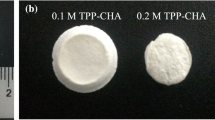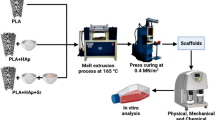Abstract
Polycaprolactone (PCL) is considered as a most widely used biodegradable polymers in tissue engineering. But, PCL is also associated with certain limitations like, low stiffness, hydrophobic nature and limited cell affinity. These drawbacks are addressed in the present study by incorporating different wt% of silicon dioxide (SiO2) and hydroxyapatite (HAp) in the PCL matrix. 3D scaffolds were developed using a novel BioExtruder. The physicochemical properties, thermal stability and wettability of the composite scaffolds were studied systematically. Optical and Scanning Electron Microscopic images were analysed for morphological evaluation of the scaffolds. The pore size of the developed scaffolds increased from 290 to 315 μm with increasing SiO2 content, as examined by scanning electron microscope. An improved compressive modulus of 68.82 MPa was observed for 15 wt% SiO2 incorporated composite scaffold. The in-vitro degradation study of the composite scaffolds demonstrated an increase in the degradation rate for PCL/HAp scaffolds, while no significant change was observed for SiO2 incorporated scaffolds. Further, the cytotoxicity and cell proliferation studies were carried out using L929 Mouse Fibroblasts and MG-63 Osteoblasts respectively. The developed scaffolds revealed no toxic effects towards the cellular response and an increase in cell proliferation of ≥90% was observed during 7 days of cell culture. Thus, the scaffolds were proved to be potential candidate for bone tissue engineering application, particularly the scaffold with 10 wt% SiO2 incorporation into PCL/HAp (75/15) composite has resulted into higher cell proliferative % and improved mechanical strength.








Similar content being viewed by others
References
De Witte TM, Fratila-Apachitei LE, Zadpoor AA, Peppas NA (2018) Bone tissue engineering via growth factor delivery: from scaffolds to complex matrices. Regen Biomater 5(4):197–211
Amini AR, Laurencin CT, Nukavarapu SP (2012) Bone tissue engineering: recent advances and challenges. Crit Rev Biomed Eng 40(5):363–408
Shrivats AR, McDermott MC, Hollinger JO (2014) Bone tissue engineering: state of the union. Drug Discov Today 19(6):781–786
Langer R, Vacanti JP (1993). Tissue Eng 260(5110):920–926
Jaganathan SK, Mani MP, Palaniappan SK, Rathanasamy R (2018) Fabrication and characterisation of nanofibrous polyurethane scaffold incorporated with corn and neem oil using single stage electrospinning technique for bone tissue engineering applications. J Polym Res 25:146
Sachlos E, Czernuszka JT (2003) Making tissue engineering scaffolds work. Eur cells mater 5:29–40
Pattanashetti NA, Hiremath C, Alves N, Kariduraganavar MY (2016) Advances in polymers and tissue engineering scaffolds. In: Inamuddin S (ed) Green polymer composites technology. CRC Press, Boca Raton, pp 343–354
Jiang W, Shi J, Li W, Sun K (2013) Three dimensional melt-deposition of polycaprolactone/bio-derived hydroxyapatite composite into scaffold for bone repair. Aust J Biol Sci 24(5):539–550
Domingos M, Dinucci D, Cometa S, Alderighi M, Bartolo PJ, Chiellini F (2009) Polycaprolactone scaffolds fabricated via bioextrusion for tissue engineering applications. Int J Biomater 1-9
Hannink G, Arts JJC (2011) Bioresorbability, porosity and mechanical strength of bone substitutes: what is optimal for bone regeneration? Injury Int J Care Injured 42:S22–S25
Sabir MI, Xu X, Li L (2009) A review on biodegradable polymeric materials for bone tissue engineering applications. J Mater Sci 44:5713–5724
Dash TK, Konkimalla VB (2012) Poly-є-caprolactone based formulations for drug delivery and tissue engineering: a review. J Control Release 158(1):15–33
Woodruff MA, Hutmacher DW (2010) The return of a forgotten polymer—Polycaprolactone in the 21st century. Prog Poly Sci 35(10):1217–1256
Stevanovic S, Chavanne P, Braissant O, Pieles U, Gruner P, Schumacher R (2013) Improvement of mechanical properties of 3d printed hydroxyapatite scaffolds by polymeric infiltration. Bioceram Dev Appl 1–3
Porter AE (2006) Nanoscale characterization of the interface between bone and hydroxyapatite implants and the effect of silicon on bone apposition. Micron 37(8):681–688
Heimann RB (2002) Materials science of crystalline bioceramics: a review of basic properties and applications. CMU J 1(1):23–46
Silva AS, Rodrigues BVM, Oliveira FC, Carvalho JO, Vasconcellos LMR, Araújo JCR, Marciano FR, Lobo AO (2019) Characterization and in vitro and in vivo assessment of poly(butyleneadipate-co-terephthalate)/nano-hydroxyapatite composites as scaffolds for bone tissue engineering. J Polym Res 26:53
Khan AF, Saleema M, Afzal A, Ali A, Khan A, Khan AR (2014) Bioactive behavior of silicon substituted calcium phosphate based bioceramics for bone regeneration. Mater Sci Eng C 35:245–252
Chuenjitkuntaworn B, Inrung W, Damrongsri D, Mekaapiruk K, Supaphol P, Pavasant P (2010) Polycaprolactone/hydroxyapatite composite scaffolds: preparation, characterization, and in vitro and in vivo biological responses of human primary bone cells. J Biomed Mater Res A 94(1):241–251
Rodriguez G, Dias J, d'Ávila MA, Bártolo P (2013) Influence of hydroxyapatite on extruded 3D scaffolds. 3rd International Conference on Tissue Engineering. ICTE2013 Procedia Engineering 59:263–269
Porter AE, Patel N, Skepper JN, Best SM, Bonfield W (2004) Effect of sintered silicate-substituted hydroxyapatite on remodelling processes at the bone–implant interface. Biomaterials 25:3303–3314
Seaborn CD, Nielsen FH (2002) Dietary silicon and arginine affect mineral element composition of rat femur and vertebra. Biol Trace Elem Res 89:239–250
Martin KR (2007) The chemistry of silica and its potential health benefits. J Nutr Health Aging 11:94–97
Ganesh N, Jayakumar R, Koyakutty M, Mony U, Nair SV (2012) Embedded silica nanoparticles in poly(Caprolactone) Nanofibrous scaffolds enhanced Osteogenic potential for bone tissue engineering. Tissue Eng A 18(17–18):1867–1881
Madhumathia K, Sudheesh Kumara PT, Kavyaa KC, Furuikeb T, Tamurab H, Nair SV, Jayakumara R (2009) Novel chitin/nanosilica composite scaffolds for bone tissue engineering applications. Int J Biol Macromol 45(3):289–292
Olmo LM, Ortega VV, Alcaraz-Baños M, Guirado LC, Regí MV, Arcos D, Baeza A (2013) In-vivo behavior of Si-hydroxyapatite/polycaprolactone/DMB scaffolds fabricated by 3D printing. J Biomed Mater Res A 101A:2038–2048
Domingos M, Chiellini F, Gloria A, Ambrosio L, Bartolo P, Chiellini E (2012) Effect of process parameters on the morphological and mechanical properties of 3D bioextruded poly(1-caprolactone) scaffolds. Rapid Prototyp J 18:56–67
Domingos M, Dinucci D, Cometa S, Alderighi M, Bartolo PJ, Chiellini F (2009) Polycaprolactone scaffolds fabricated via bioextrusion for tissue engineering applications. Int J Biomater 2009:1–9
Domingos M, Intranuovo F, Gloria A, Gristina R, Ambrosio L, Bartolo PJ, Favia P (2013) Improved osteoblast cell affinity on plasma-modified 3-D extruded PCL scaffolds. Acta Biomater 9:5997–6005
Costa-Pinto AR, Martins AM, Castelhano-Carlos MJ, Correlo VM, Sol PC, Longatto-Filho A, Battacharya M, Reis RL, Nuno MN (2014) In vitro degradation and in vivo biocompatibility of chitosan-poly(butylene succinate) fiber mesh scaffolds. J Bioact Compat Polym 29:137–151
Pattanashetti NA, Hiremath C, Naik SR, Heggannavar GB, Kariduraganavar MY (2020) Development of nanofibrous scaffolds by varying the TiO2 content in crosslinked PVA for bone tissue engineering. New J Chem 44:2111–2121
Murphy CM, Haugh MG, O’Brien FJ (2010) The effect of mean pore size on cell attachment, proliferation and migration in collagen–glycosaminoglycan scaffolds for bone tissue engineering. Biomaterials 31(3):461–466
Baksh D, Davies JE, Kim S (1998) Three-dimensional matrices of calcium polyphosphates support bone growth in vitro and in vivo. J Mater Sci Mater Med 9(12):743–748
Lee SJ, Lee IW, Lee YM, Lee HB, Khang G (2004) Macroporous biodegradable natural/ synthetic hybrid scaffolds as small intestine submucosa impregnated poly-(D, L-lactide-co-glycolide) for tissue-engineered bone. J Biomater Sci Polym Ed 15:1003–1017
Castro AGB, Diba M, Kersten M, Jansen A, van den Beucken JJJP, Yang F (2018) Development of a PCL-silica nanoparticles composite membrane for guided bone regeneration. Mater Sci Eng C 85:154–161
Razak SIA, Sharif NFA, Rahman WAWA (2012) Biodegradable polymers and their bone Appications: a review. Int J Basic Appl Sci 12(1):31–49
Shin K, Koh Y, Kim H (2013) Synthesis and characterization of drug-loaded poly(휀-caprolactone)/Silica hybrid Nanofibrous scaffolds. J Nanomaters 1–12
Lee H, Hwang H, Kim Y, Jeon H, Kim GH (2014) Physical and bioactive properties of multi-layered PCL/silica composite scaffolds for bone tissue regeneration. Chem Eng J 250:399–408
Sowjanya JA, Singh J, Mohita T, Sarvanan S, Moorthi A, Srinivasan N (2013) Selvamurugan N. biocomposite scaffolds containing chitosan/alginate/nano-silica for bone tissue engineering. Colloids Surf B: Biointerfaces 109:294–300
Gao C, Wei P, Feng P, Xiao T, Shuai C, Peng S (2015) Nano SiO2 and MgO improve the properties of porous β-TCP scaffolds via advanced manufacturing technology. Int J Mol Sci 16(4):6818–6830
Acknowledgements
Authors wish to thank the DST, New Delhi, for extending the financial support under DST-PURSE-Phase-II Program (Grant No. SR/PURSE-Phase-2/3-G). Authors will remain grateful to Skanda Life Sciences Pvt. Ltd., Bangalore, for supporting the cell culture study.
Author information
Authors and Affiliations
Corresponding author
Ethics declarations
Conflict of interest
There are no conflicts to declare.
Additional information
Publisher’s note
Springer Nature remains neutral with regard to jurisdictional claims in published maps and institutional affiliations.
Rights and permissions
About this article
Cite this article
Pattanashetti, N.A., Viana, T., Alves, N. et al. Development of novel 3D scaffolds using BioExtruder by varying the content of hydroxyapatite and silica in PCL matrix for bone tissue engineering. J Polym Res 27, 87 (2020). https://doi.org/10.1007/s10965-020-02053-0
Received:
Accepted:
Published:
DOI: https://doi.org/10.1007/s10965-020-02053-0




